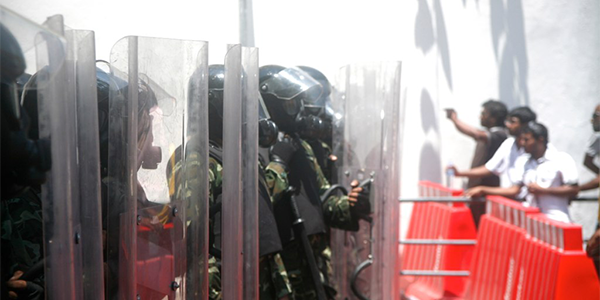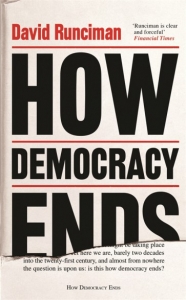Book Review | How Democracy Ends by David Runciman
Is democracy in crisis? In How Democracy Ends, David Runciman offers a compelling and convincing account of the state of democracy today, separating clear threats from alarmism in an accessible, well-written and thoughtful book. Sean Kippin recommends this to anyone seeking to understand our current predicament and the future paths for democracy – if any – ahead.
 Picture: (Dying Regime CC BY 2.0)
Picture: (Dying Regime CC BY 2.0)
How Democracy Ends. David Runciman. Profile Books. 2018.

Regular listeners to the superb ‘Talking Politics’ podcast, in which a select group of Cambridge academics take a detached and thoughtful look at political goings on both British and international, will know about host David Runciman’s gift for separating the signal from the noise. In this extremely thoughtful book, How Democracy Ends, he identifies what does and does not threaten contemporary democracy, what is and isn’t alarmism, and without being either too prescriptive nor overreaching in his perspective, which of today’s popular arguments concerning the threats to democracy we face should and shouldn’t be taken seriously. It is a highly readable work which impressively surveys the terrain, zooming in and out at key moments, bringing in outside voices and views and marshalling the points compellingly and convincingly.
Runciman’s argument is logically sequenced and highly comprehensible. The book begins by sketching some of the main arguments of authors such as Timothy Snyder who accept, perpetuate or propose the argument that the developments of recent years – democratic backsliding in young democracies and old, a reinvigorated far right, the chipping away at democratic norms and structures – suggest a degree of commonality with the events of the 1930s, which saw a seemingly established and stable democracy in Weimar-era Germany give way to Nazi totalitarian rule and all else that lamentably followed. Throw in contemporary issues surrounding technology, and it can plausibly be argued that we stand on a new precipice, with authoritarian rulers like Viktor Orbán, Vladimir Putin, and yes, Donald Trump, marking the future of ‘democratic’ government. Runciman takes issue with these arguments as his starting point, contending that we should not allow unpleasant echoes of this earlier era to blind us to the reality of what is unfolding before our eyes.
The book is structured around four central themes; ‘Coup!’; ‘Catastrophe!’; ‘Technological Takeover!’; and ‘Something Better?’. In the first, Runciman explores the possibility of some kind of formal government takeover by outside sources – either along traditional military lines or alternatively something less visible but equally subversive. Runciman argues that our contemporary democracies lack key ingredients for the former: our societies are too affluent, networked and old for that. He uses the example of Greece, which suffered a ‘real’ military coup in 1967, and contrasts it with the ‘silent coup’ many years later in which the ‘troika’ of the International Monetary Fund, the European Central Bank and the European Commission decisively influenced Greek fiscal policy in a direction utterly at odds with the sentiment of the Greek population, illustrating that changed circumstances make the events of 1967 almost unthinkable today.
The subsequent section ‘Catastrophe!’ discusses the potentially galvanising effects of climate change and nuclear conflict in facilitating radical political change. Runciman instead argues convincingly that the effect is to the contrary, rather creating – such as in the case of the recent nuclear standoff between Presidents Trump and Kim Jong-un – a kind of stultifying and jaded inaction. Runciman argues that if true catastrophe occurs, saving democracy will not be high on the agenda, particularly if we end up living out some version of Cormac McCarthy’s The Road.
Having discussed the notion that either political violence in the form of a coup or takeover of some kind on the one hand, or a catastrophe on the other, will spell the end of our wavering democracies, Runciman moves on to the issue of technology and its myriad threats to democracy. He acknowledges that seeking to predict the future is absurd given the almost unlimited range of possibilities, encompassing killer robots and technology that anticipates our preferences without ever seeking to expand our horizons or encourage us to imbibe new information. This section is the book’s strongest, displaying an admirable clarity in marshalling the core sections of this impossibly complicated and possibility-filled terrain. Ultimately, he proposes that democracy may well end in its current form, and if and when it does, it will be the result of hollowed-out institutions which give the form and not the reality of democracy. American democracy will survive Trump, but may do so in a damaged condition – but it won’t be Trump alone that caused this. Rather, it will be a grinding away due to a number of interlocking and longstanding factors that transcend any one individual, regardless of their seemingly unlimited mendacity and complete indifference to democratic norms and values.
One immediate question which struck was why there wasn’t a greater exploration within the book’s narrative of those longstanding economic factors that have led to the difficult situation in which we find ourselves. A great success of the neoliberal right, following its initial triumphs in the late 1970s, has been the recasting of democracy as referring to a narrow set of primarily legal institutions, limited largely to elected representatives, an independent judiciary and press and an observed set of rights and freedoms. It is with this conception that Runciman deals in this book. However, what neoliberal politicians sought was the destruction of another kind of democracy, perpetrated through the erosion of trade unions, the institutions of economic democracy and working-class solidarity and the kinds of industries that gave power and influence to the working and middle classes.
While not fatally undermining any of Runciman’s analysis, a greater exploration of the role that these processes played in bringing us to where we are today would have perhaps strengthened his argument. Beyond this, a deliberate rebuilding of those institutions of economic democracy and solidarity hold a great degree of potential for reversing the atomisation of society that current economic trends have created, which play into many contemporary problems. The work of painstakingly rebuilding unions, creating workers councils and democratising businesses may be unglamorous, but it may well be the key to salvaging democracy. An exploration (even if only to knock them down) of these ideas in the chapter ‘Something Better?’, which sketches out some alternatives or modifications to democracy such as the fascinating but ultimately unworkable idea of epistocracy (or rule by the most knowledgeable), would be particularly welcome.
In the end, How Democracy Ends is an excellent book: it is well-written, evenly paced, accessible, non-academic in tone but very much so in rigour and thoughtfulness. It is sceptical but not pessimistic, and warnful but not alarmist. There is even some humour. It is heartily recommended for anyone who seeks to understand our current malaise and interested in this question of how democracy got to where it is today, and where it may go – if anywhere – next.
This review gives the views of the author, and not the position of Democratic Audit. It was first published on the LSE Review of Books blog.
Sean Kippin is a Doctoral Candidate at the University of the West of Scotland, and the Commissioning Editor of the LSE British Politics and Policy blog. He was formerly Managing Editor of Democratic Audit UK, and is an author of the 2017 Audit of UK Democracy, and The UK’s Changing Democracy: The 2018 Democratic Audit (forthcoming). Read more by Sean Kippin.





 Democratic Audit's core funding is provided by the Joseph Rowntree Charitable Trust. Additional funding is provided by the London School of Economics.
Democratic Audit's core funding is provided by the Joseph Rowntree Charitable Trust. Additional funding is provided by the London School of Economics.